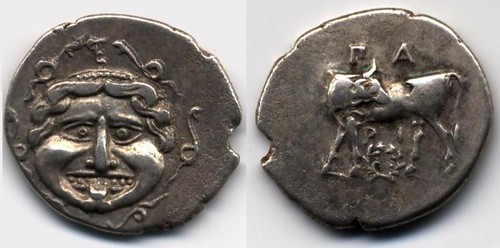
PREV ARTICLE
FULL ISSUE
PREV FULL ISSUE
FEATURED WEB PAGE: GORGONS OF PARIONThis week's Featured Web Page is an article on the Gorgons of Parion from Ed Snible's web site.The hemidrachm from Parion has an unusual design: a staring female face with tongue protuding, surrounded by snakes. The reverse shows a bull standing left and looking back. The greek letters ?? appears above the bull and ?? is between the legs of the bull. We know these coins come from Parion because of the legend: ????, the Greek letters for PARI. The face is the "gorgoneion," a mask in imitation of the head of the gorgon. In archaic and classical Greek art gorgons were always shown facing the viewer, protruding tongue, and teeth. Very early ones were sometimes depicted with beards, but never on coins. In Greek mythology there were three gorgon sisters. The most famous was Medusa who was decapited by the hero Perseus. The hair of gorgons was never depicted as living snakes in ancient times. The snakes, if any, were shown near or later sometimes in the hair. Sometimes the gorgon head had wings, but never on the coins of Parion. It isn't clear why Parion chose a hideous monster as an emblem for the city. Perhaps it was chosen as a symbol of terror. It was used on Greek shields to frighten the enemy as well as for it's hypnotic ability--something about the gorgoneion attracts gaze of enemy soldiers toward the shield and thus away from the weapon hand. Could the gorgon head on Parion's coins represent military shields and ability of Parion's military?  http://snible.org/coins/parion.htmlWayne Homren, Editor The Numismatic Bibliomania Society is a non-profit organization promoting numismatic literature. See our web site at coinbooks.org. To submit items for publication in The E-Sylum, write to the Editor at this address: whomren@gmail.com To subscribe go to: https://my.binhost.com/lists/listinfo/esylum All Rights Reserved. NBS Home Page Contact the NBS webmaster 
|